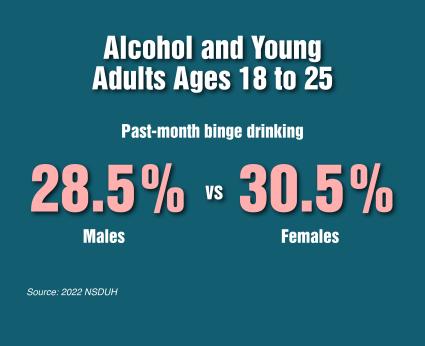Alcohol and Young Adults Ages 18 to 25
Prevalence of Alcohol Use
Prevalence of Past-Month Drinking
According to the 2022 National Survey on Drug Use and Health (NSDUH), 17.5 million young adults ages 18 to 25 (50.2% in this age group) reported that they drank alcohol in the past month.1,2 This includes:
- 8.5 million males ages 18 to 25 (48.6% in this age group)1,2
- 9.0 million females ages 18 to 25 (51.8% in this age group)1,2
- 805,000 Asian young adults ages 18 to 25 (35.5% in this age group)1,2
- 1.8 million Black or African American young adults ages 18 to 25 (38.6% in this age group)1,2
- 10.5 million White young adults ages 18 to 25 (57.5% in this age group)1,2
- 506,000 young adults of two or more races ages 18 to 25 (50.4% in this age group)1,2
- 3.7 million Hispanic or Latino young adults ages 18 to 25 (45.1% in this age group)1,2
- Estimates for American Indian or Alaska Native and Native Hawaiian or other Pacific Islander young adults ages 18 to 25 were not presented because they were based on a relatively small number of respondents or had a large margin of error.1,2
According to the 2022 NSDUH, 4.8 million full-time college students ages 18 to 25 (51.5%) and 12.3 million other persons of the same age (50.0%) reported that they drank alcohol in the past month.3
Prevalence of Past-Month Binge Drinking

According to the 2022 NSDUH, 10.3 million young adults ages 18 to 25 (29.5% in this age group) reported binge drinking in the past month (see glossary for definition of binge drinking).4,5 This includes:
- 5.0 million males ages 18 to 25 (28.5% in this age group)4,5
- 5.3 million females ages 18 to 25 (30.5% in this age group)4,5
- 333,000 Asian young adults ages 18 to 25 (14.7% in this age group)4,5
- 977,000 Black or African American young adults ages 18 to 25 (20.9% in this age group)4,5
- 6.2 million White young adults ages 18 to 25 (34.0% in this age group)4,5
- 307,000 young adults of two or more races ages 18 to 25 (30.6% in this age group)4,5
- 2.3 million Hispanic or Latino young adults ages 18 to 25 (28.2% in this age group)4,5
- Estimates for American Indian or Alaska Native and Native Hawaiian or other Pacific Islander young adults ages 18 to 25 were not presented because they were based on a relatively small number of respondents or had a large margin of error.4,5
According to the 2022 NSDUH, 2.7 million full-time college students ages 18 to 25 (29.0%) and 7.3 million other persons of the same age (29.7%) reported binge drinking in the past month.3
Prevalence of Past-Month Heavy Alcohol Use
According to the 2022 NSDUH, 2.6 million young adults ages 18 to 25 (7.6% in this age group) reported heavy alcohol use in the past month (see glossary for definition of heavy alcohol use).6,7 This includes:
- 1.5 million males ages 18 to 25 (8.6% in this age group)6,7
- 1.1 million females ages 18 to 25 (6.5% in this age group)6,7
- 49,000 Asian young adults ages 18 to 25 (2.2% in this age group)6,7
- 162,000 Black or African American young adults ages 18 to 25 (3.5% in this age group)6,7
- 1.8 million White young adults ages 18 to 25 (9.9% in this age group)6,7
- 71,000 young adults of two or more races ages 18 to 25 (7.1% in this age group)6,7
- 520,000 Hispanic or Latino young adults ages 18 to 25 (6.3% in this age group)6,7
- Estimates for American Indian or Alaska Native and Native Hawaiian or other Pacific Islander young adults ages 18 to 25 were not presented because they were based on a relatively small number of respondents or had a large margin of error.6,7
According to the 2022 NSDUH, 700,000 full-time college students ages 18 to 25 (7.4%) and 1.9 million other persons of the same age (7.7%) reported heavy drinking in the past month.3
Prevalence of High-Intensity Drinking
According to the 2019 Monitoring the Future (MTF) survey, 12.0% of college students and 12.0% of young adults not in college engaged in high-intensity drinking (see the MTF bullet in the glossary definition of high-intensity drinking).8
Consequences of Alcohol Use
- Alcohol is a factor in the deaths of thousands of young people every year in the United States. The most recent National Institute on Alcohol Abuse and Alcoholism statistics estimate that this includes 1,519 college students ages 18 to 24 and 2,586 persons the same age who die from alcohol-related unintentional injuries, including motor vehicle crashes.9
- According to the 2022 NSDUH, 16.4% of adults ages 18 to 25 met the criteria for past-year alcohol use disorder (AUD).10 Within this age group, 14.1% of full-time college students ages 18 to 25 and 16.7% of other persons of the same age met the criteria for AUD.11
- Although estimating the number of alcohol-related sexual assaults is exceptionally challenging because sexual assault is typically underreported, researchers have confirmed a long-standing finding that 1 in 5 college women experience sexual assault during their time in college.12 A majority of sexual assaults in college involve alcohol or other substances.13,14 Research continues to better understand the relationship between alcohol and sexual assault among college students. Additional national survey data are needed to better estimate the number of alcohol-related assaults.

